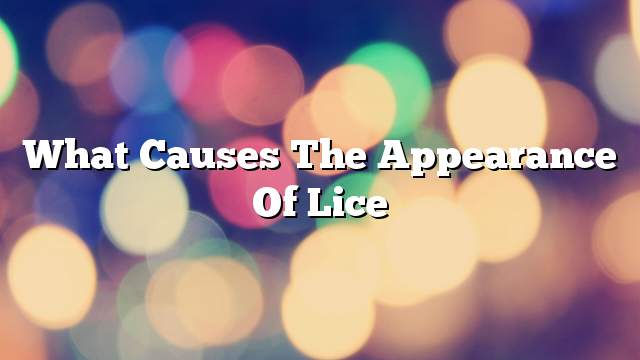Lice
The most important problems of hair in particular the problem of the emergence of lice or head lice, a kind of harmful insects that feed on human blood, and is characterized by being small parasitic beings with a transparent white color turns brown after feeding on blood. The type of lice varies according to the area in which they live in the human body, it is divided into three main types called: head lice, lice, and pubic lice. When the person is exposed to lice, he has many signs, mainly small ulcers in different parts of the body, severe itching, and also (with the help of a magnifying glass in particular) can see the adult lice insects crawling on the hair, or see the pools of eggs planted at the hair shaft The injured person. The spread of lice lesion among people in different ways and means This article explains the most important.
the description
Lice males range from 2 to 3.5 millimeters, while females are 3.5 to 4.5 mm. The head of this insect is conical and slightly long, and is connected by a pair of sensor horns, but it lacks almost the eyes (they are either inert or nonexistent), and the shape of its mouth varies from the piercing perforated to the jaw. She does not have any wings, and each of her legs has a claw like a hook to help her cling to the body of her victim. These organisms breathe through holes on the sides of their abdomen.
Lice problems
Lice is a very small insect, characterized by its lack of wings, and the fact that it lives a parasitic life as a scourge. Vail is not only human, but it is spread among many species of mammals and birds that live hidden between her hair and feathers to suck her blood time after time. In addition to the fact that lice infestation causes severe itching and itching, it may also play a role in the transmission of serious diseases, such as typhoid disease that can lead to death. But not all types of lice absorb blood, it is also a kind of chewing and eating vegetarian and organic, and in fact the number of lice chewing in nature ten times the lice sucking.
Types of lice
Lice are divided into many species and species, but there are three basic groups that affect the human body:
- Head lice It is called head lice because of its presence in the hair of the head, especially in the back of the neck and behind the ears. This type is widespread in children, especially children in nurseries and schools.
- Body lice : This type of lice exist in the body, where the female puts her eggs between the folds of clothing, and move her children to the body to get food.
- Pubic lice : This type of lice exists and proliferate in the pubic area and around the anus. In rare cases, lice can appear on facial hair, eyelashes, armpit hair, or even chest hair.
life cycle
Lice life cycle consists of several stages, can be divided into three basic, namely egg, nymph, and puberty. Most lice prefer laying their eggs (also called pupae) on the hair shaft of the host organism. The lice secrete a sticky substance that makes its eggs stick to the ends of the hair follicles. The eggs can also be placed in the human clothing folds. The shape of the eggs of lice in the form of white droplets resembling eye tears, called wolves. Lice eggs hatch after six to ten days, and egg shells can sometimes remain hair-hanging after hatching, and it is difficult to distinguish whether they contain the lice embryo or not. After the maturation of the egg comes out of the nymph, and looks like an adult insect, but the color is white or transparent, and it feeds on scalp blood, and live for 10 to 20 days, during which several clumps of the outer cover prepare for puberty, where the nymph develops to become a full-grown louse. It is characterized by lice brown or gray, and live for thirty days on the body of the breadwinner, which may put a number of 200 to 300 eggs.
Causes of lice emergence
Cleanliness neglect
Lice tend to live in places that are not exposed to water. The hair that is exposed to water, as well as the body that is washed daily with water, is less susceptible to lice. Lice loves dry places that do not reach the water, preferably areas that produce sweat and accumulated fat, Do not bathe. Lice prefer to move from the body through soiled clothes, which are full of dirt and odors, they are vulnerable to crawling lice. In this sense, lice infection is more common in environments that are soiled or overcrowded and under-served, for example refugee camps and displaced populations.
Infection
One of the easiest and most important causes of lice is direct contact with an infected person, or sharing personal interests with him. Just sharing the clothes cut can be enough to move the lice between two people, as the personal purposes and especially the hair accessories of combs and bedding cause the transmission of lice infestation very easily. In addition, direct contact with the infected person is sometimes sufficient to spread the infection. For this reason, young children (generally three to ten years old, especially kindergarten children) are most likely to catch lice infections because they contact repeatedly with Their friends in school or nursery, sharing their things with them, moving lice from one child to another. For the same reason, children’s families can also be exposed to infection, and in general, females are more likely to be infected than males.
